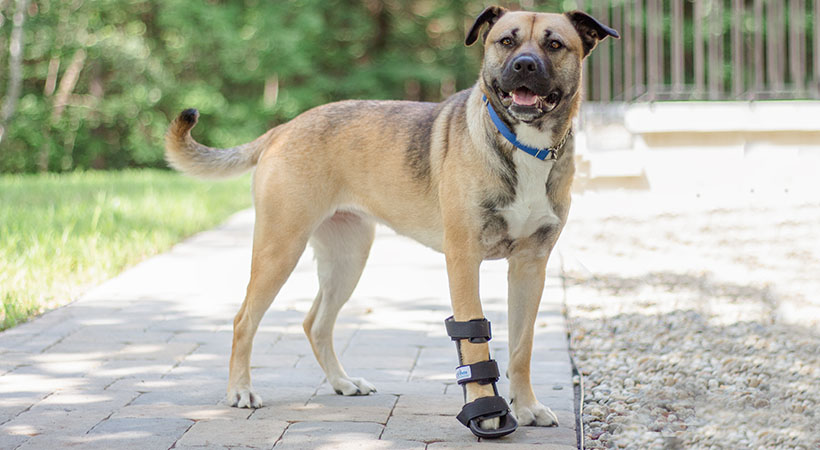The Splint Placement Must Be Appropriate
At all times work together with your veterinarian to make sure your canine’s splint is positioned appropriately. An improperly fitted or positioned splint could cause pores and skin irritation, swelling, and harm. Your veterinarian will assist choose the suitable leg splint to verify the splint is supporting the injured portion of your canine’s leg. The proper splint ought to assist above and under the injured joint or ligament.
Easy methods to inform {that a} canine’s splint matches appropriately:
- All toes and paw match comfortably within the paw portion of the splint.
- Straps are comfortable however not too tight.
- The pet’s leg matches comfortably into the splint.
- The bend within the splint completely aligns together with your canine’s pure leg form.
The Match Ought to Be Comfortable, However Not Tight
A splint ought to suit your canine snugly however shouldn’t be too tight or uncomfortable. Search for indicators that your pet’s splint is simply too small. Are the toes hanging out over the sting of the splint? Is your pet’s pores and skin bulging over the straps or sides of the splint? A too-small splint could be uncomfortable and will trigger extra harm.
Indicators the splint is simply too small:
- The paw portion of the splint isn’t lengthy or huge sufficient.
- The canine’s fur or pores and skin is bulging over the strap or sides.
- The bend within the splint sits under the carpal or hock joint.
- The leg won’t match absolutely into the splint.
The Splint Ought to Not Be Too Unfastened
Your pet’s splint ought to match comfortably. If a canine splint is simply too unfastened, it might trigger the splint to shift or transfer unexpectedly. As soon as the splint is in your canine, search for indicators of gapping, or areas the place the splint isn’t touching your canine’s leg – this might imply the splint is simply too large and never providing sufficient assist to the limb.
Indicators the splint is simply too large:
- Splint size goes too excessive up on the leg.
- The bend within the splint sits above the carpal or hock joint.
- The splint shifts or strikes by itself.
- The paw portion of the splint is simply too huge.
- The pet can simply take away the splint.
At all times Examine to Keep away from Overtightening
A very tight splint can result in swelling, place pointless stress on the limb, and be painful. After positioning the splint, have a look at your canine’s toes, paw, and leg. Are there any indicators of swelling, irritation, or change in shade? If that’s the case, your canine’s splint is simply too tight or doesn’t match correctly. Contact your veterinarian in case your canine’s limb is swollen, chilly to the touch, or every other change in look after making use of a splint.
To keep away from by chance overtightening your pet’s splint straps, by no means tighten from the highest down or backside up. This could typically trigger you to progressively tighten as you’re employed your method down or up. As an alternative, tighten the underside strap first, then modify the highest strap earlier than transferring on to the center straps. Afterward, verify every strap. If adjusted appropriately, it is best to have the ability to slide a finger comfortably beneath every strap.
Splint Greatest Practices:
- Hold the splint dry and clear.
- Restrict your canine’s train, keep away from leaping whereas carrying the splint.
- Leash your canine when going exterior to restrict exercise.
- Recurrently verify your pet’s leg for pores and skin irritation or indicators of rubbing.
- Have the splint positioned by a veterinary skilled.
Earlier than attempting a splint, your veterinarian ought to assess your canine’s harm to find out whether or not a splint is the suitable remedy choice on your pet.
When Introducing a Splint to Your Pet:
Be sure you at all times begin slowly when introducing new merchandise to your pet. Monitor your pet for indicators of rubs or tightness and take away the splint if these develop into current. We suggest having your pet put on the splint for 5-10 minutes at a time till you’re sure the match is acceptable, and your pet is snug carrying the splint.
If there are any areas of concern, please attain out to our Buyer Care Crew or consult with your common Veterinarian, as a distinct measurement could also be extra applicable.
Associated Articles:


